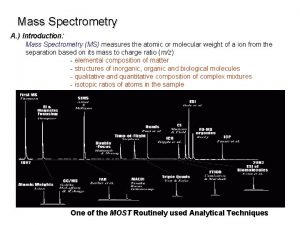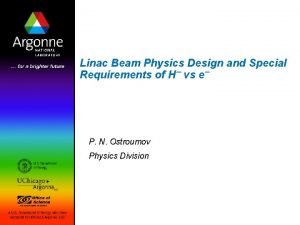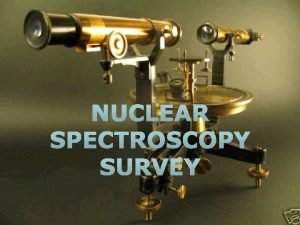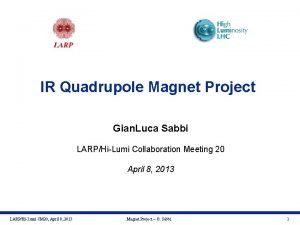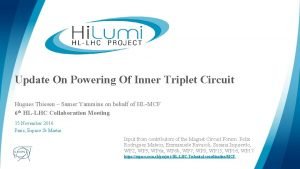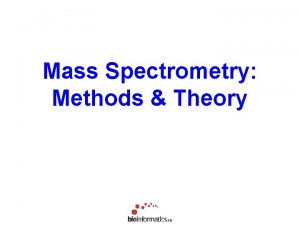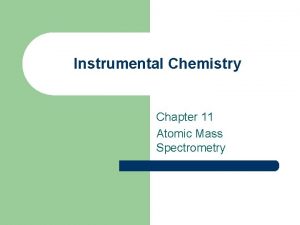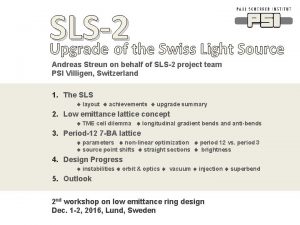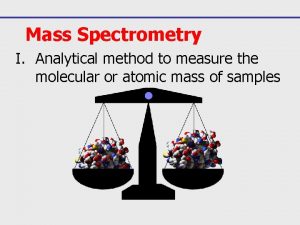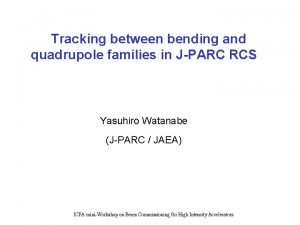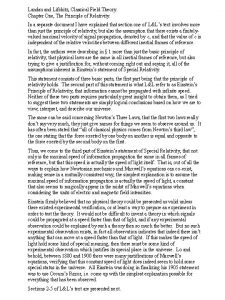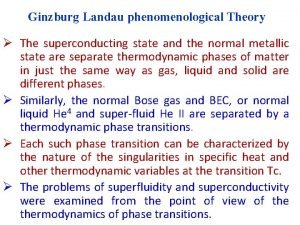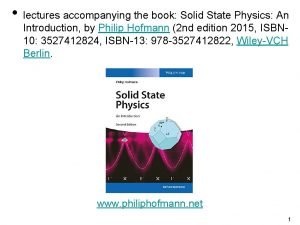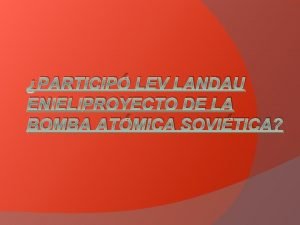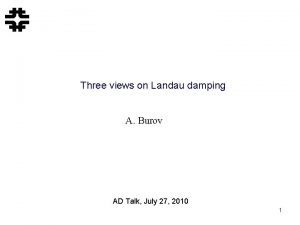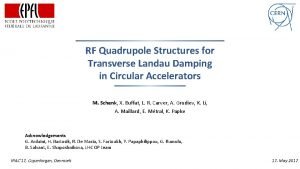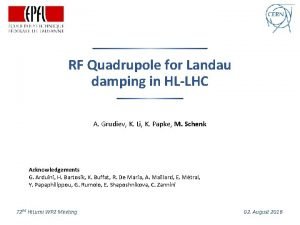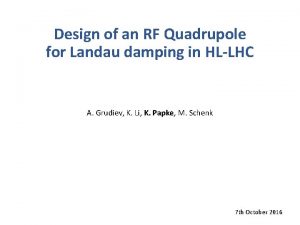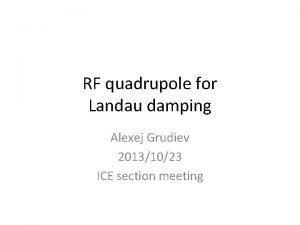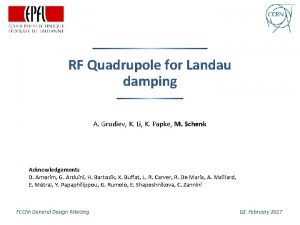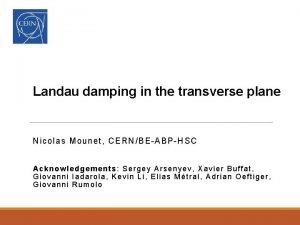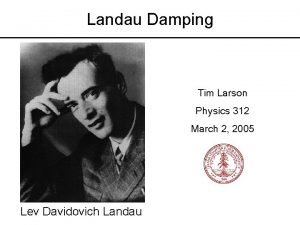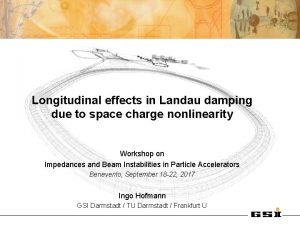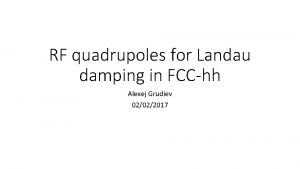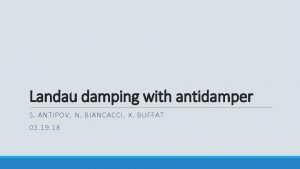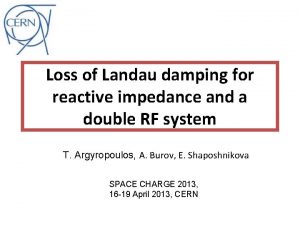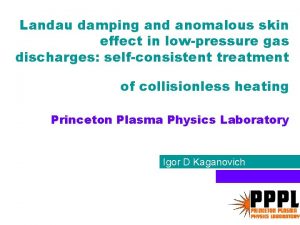RF Quadrupole Structures for Transverse Landau Damping in



![witness v≈c 0 -15 0 2· 105 4· 105 Time [turns] 6· 105 Q witness v≈c 0 -15 0 2· 105 4· 105 Time [turns] 6· 105 Q](https://slidetodoc.com/presentation_image_h2/3b2dfb252a2cde207b82a9cca05736c3/image-4.jpg)





![The Py. HEADTAIL model[8] Interaction point • Wake field kicks • Chromaticity • Octupoles, The Py. HEADTAIL model[8] Interaction point • Wake field kicks • Chromaticity • Octupoles,](https://slidetodoc.com/presentation_image_h2/3b2dfb252a2cde207b82a9cca05736c3/image-10.jpg)
![Numerical proof of concept (I) Py. HEADTAIL Bunch centroid [a. u. ] LHC experiment[9] Numerical proof of concept (I) Py. HEADTAIL Bunch centroid [a. u. ] LHC experiment[9]](https://slidetodoc.com/presentation_image_h2/3b2dfb252a2cde207b82a9cca05736c3/image-11.jpg)




![Experimental Py. HEADTAIL studies[12, 13] with detailed impedance and MAD-X optics model at Ioct Experimental Py. HEADTAIL studies[12, 13] with detailed impedance and MAD-X optics model at Ioct](https://slidetodoc.com/presentation_image_h2/3b2dfb252a2cde207b82a9cca05736c3/image-16.jpg)
![Experimental Py. HEADTAIL studies[12, 13] with detailed impedance and MAD-X optics model at Ioct Experimental Py. HEADTAIL studies[12, 13] with detailed impedance and MAD-X optics model at Ioct](https://slidetodoc.com/presentation_image_h2/3b2dfb252a2cde207b82a9cca05736c3/image-17.jpg)

![References (I) [1] A. Grudiev, Radio frequency quadrupole for Landau damping in accelerators, Phys. References (I) [1] A. Grudiev, Radio frequency quadrupole for Landau damping in accelerators, Phys.](https://slidetodoc.com/presentation_image_h2/3b2dfb252a2cde207b82a9cca05736c3/image-19.jpg)
![References (II) [10] X. Buffat, Transverse beams stability studies at the Large Hadron Collider, References (II) [10] X. Buffat, Transverse beams stability studies at the Large Hadron Collider,](https://slidetodoc.com/presentation_image_h2/3b2dfb252a2cde207b82a9cca05736c3/image-20.jpg)

- Slides: 21

RF Quadrupole Structures for Transverse Landau Damping in Circular Accelerators M. Schenk, X. Buffat, L. R. Carver, A. Grudiev, K. Li, A. Maillard, E. Métral, K. Papke Acknowledgements G. Arduini, H. Bartosik, R. De Maria, S. Fartoukh, Y. Papaphilippou, G. Rumolo, E. Shaposhnikova, LHC OP team IPAC’ 17, Copenhagen, Denmark 17. May 2017

Contents • • • Introduction Working principle Numerical simulations Experimental studies Summary and outlook M. Schenk et al. 2 17. 05. 2017

Contents • • • Introduction Working principle Numerical simulations Experimental studies Summary and outlook M. Schenk et al. 3 17. 05. 2017
![witness vc 0 15 0 2 105 4 105 Time turns 6 105 Q witness v≈c 0 -15 0 2· 105 4· 105 Time [turns] 6· 105 Q](https://slidetodoc.com/presentation_image_h2/3b2dfb252a2cde207b82a9cca05736c3/image-4.jpg)
witness v≈c 0 -15 0 2· 105 4· 105 Time [turns] 6· 105 Q 0 ΔQc stable 0 Tune Q 4 20 0 -20 -0. 2 -0. 1 0. 2 z [m] 2 This increases the stable area in the complex tune space 3 With large enough spread, the instability can be suppressed unstable -Im(ΔQc) 0 M. Schenk et al. 15 We want to generate a large enough incoherent tune spread ΔQ Re (ΔQc) Tune distribution A solution: Landau damping 1 2 source wake field Wake kicks can drive (head-tail) instabilities characterised by the complex coherent tune shift ΔQc and a mode pattern Head-tail ampl. [a. u. ] Source particle interacts electro-magnetically with the accelerator structure / impedance Creates wake field that acts back on trailing particles (witnesses) Bunch centroid [µm] 1 (Impedance-driven) Problem: Collective instabilities … and a way around them Re(ΔQc) 17. 05. 2017

How to generate tune spread? 1 Magnetic octupoles Betatron detuning with transverse amplitude 2 RF quadrupole[1 -3] Betatron detuning with longitudinal amplitude Not to be confused with the RFQ used in Linacs! M. Schenk et al. 5 17. 05. 2017

1 2 LHC nominal at 7 Te. V 2 RF quadrupole (≈ 1 m) LHC Landau octupoles (≈ 56 m) Potential advantages of an RF quadrupole 1 1/γ 2 7 1 m of RF quadrupole produces same RMS tune spread as max. LHC octupoles (@7 Te. V) - ΔJx, y << ΔJz (LHC nom. , 7 Te. V: factor 104 – 105)[1, 4] - Jz provides much larger handle for detuning Higher energy machines - Octupoles: affected by adiabatic damping & higher beam rigidity (1/γ 2) - RF quadrupole: only affected by higher beam rigidity (1/γ) (thanks to longitudinal blow up[5]) 3 Higher intensity / higher brightness beams 4 Manipulations in the transverse planes M. Schenk et al. - Potentially more violent instabilities - Smaller transverse emittance makes octupoles less effective - E. g. halo cleaning: can decrease octupole detuning efficiency, while the RF quadrupole is unaffected 6 17. 05. 2017

Basic working principle of an RF quadrupole J. Scott Berg and F. Ruggiero developed basic stability diagram theory for detuning with Jz[6] -Im(ΔQc) [a. u. ] 1 RF-modulated quadrupole kick b(2) [T/m m] denotes the integrated quadrupolar gradient 2 Translates into a betatron detuning unstable Re(ΔQc) [a. u. ] (assume ϕ 0 = 0) 2 nd order: Detuning with longitudinal action M. Schenk et al. unstable • Theory is approximate and does not include all the beam dynamics At present best addressed with tracking simulations • Asymmetry in the two planes can be reduced with a two-family scheme (see [7] for details) 7 17. 05. 2017

Add a ‘side note’: RF quadrupole has been studied to increase TMCI (strong head-tail) threshold. Not further pursued due to high required strength -> problem of resonances a. o. Here: For Landau damping of weak head-tail modes, we operate in a different regime (put pictures). M. Schenk et al. 8 17. 05. 2017

Contents • • • Introduction Working principle Numerical simulations Experimental studies Summary and outlook M. Schenk et al. 9 17. 05. 2017
![The Py HEADTAIL model8 Interaction point Wake field kicks Chromaticity Octupoles The Py. HEADTAIL model[8] Interaction point • Wake field kicks • Chromaticity • Octupoles,](https://slidetodoc.com/presentation_image_h2/3b2dfb252a2cde207b82a9cca05736c3/image-10.jpg)
The Py. HEADTAIL model[8] Interaction point • Wake field kicks • Chromaticity • Octupoles, RF quadrupole • Electron cloud (Py. ECLOUD) • … Linear periodic maps for transverse tracking from one IP to the next y 2 Initialise bunch • Typically macroparticles • Various distributions possible: Gaussian, matched to rf bucket, waterbag, … 7 100’ 000 s turns … 15 z x 6 1 Data acquisition 5 106 M. Schenk et al. Wake kicks Courtesy K. Li Divide ring into segments separated by interaction points (IP) 10 Once per turn: Apply (non-)linear synchrotron motion 0 -15 0 Head-tail ampl. [a. u. ] 4 Bunch centroid [µm] 3 Wake field 2· 105 4· 105 6· 105 Time [turns] 20 0 -20 -0. 2 -0. 1 0 z [m] 0. 1 0. 2 17. 05. 2017
![Numerical proof of concept I Py HEADTAIL Bunch centroid a u LHC experiment9 Numerical proof of concept (I) Py. HEADTAIL Bunch centroid [a. u. ] LHC experiment[9]](https://slidetodoc.com/presentation_image_h2/3b2dfb252a2cde207b82a9cca05736c3/image-11.jpg)
Numerical proof of concept (I) Py. HEADTAIL Bunch centroid [a. u. ] LHC experiment[9] • • Stability diagram theory 2 0 -2 0 4· 105 Turn 8· 105 1. 2· 106 LHC at 3. 5 Te. V, single bunch Head-tail instability m = -1 Rise time τ ≈ 10 s at Ioct = -10 A Cured with octupoles Ioct = -15 ± 5 A • • • Same m = -1 instability Rise time • τ ≈ 4. 5 s at Ioct = -10 A • τ ≈ 12. 8 s at Ioct = -15 A Ioct = -17. 5 ± 2. 5 A • • • Circulant matrix model (Bim. Bim[10]) to solve eigenvalue equation Again m = -1 instability Ioct = -17. 5 ± 1 A Excellent agreement between experiment, tracking, and theory • Solid understanding of the involved mechanisms • Landau damping from octupoles responsible for mitigation • Py. HEADTAIL models the machine accurately (a. o. reliable impedance model) and reproduces observations, in particular the Landau damping mechanism Ideal study case to address the stabilising effect of an RF quadrupole M. Schenk et al. 11 17. 05. 2017

Numerical proof of concept (II) RF quadrupoles Magnetic octupoles What happens if we replace octupoles with RF quadrupoles? • As expected from theory, the RF quadrupole mitigates the instability, similarly to octupoles • Strength can be achieved with a single cavity • Active length ≈ 0. 15 m • Landau octupole current of -17. 5 ± 2. 5 A is required for stabilisation • Corresponds to active length ≈ 1. 5 m (LHC octupoles at max. strength) Factor 10 difference in required active lengths for this particular instability. Expected to become even better at higher energies. M. Schenk et al. 12 17. 05. 2017

HL-LHC Py. HEADTAIL study: Synergy between octupoles and RF quadrupole Q’ = 10 • • HL-LHC, single nominal bunch, 7 Te. V[11] Working point Q’ = 10 Head-tail mode (0, 2) – as observed in the LHC Without RF quadrupole: LHC Landau octupole current Ioct = (170 ± 10) A is required for stabilisation (accounting for impedance only) M. Schenk et al. 13 RF quadrupole (≈ 0. 5 m) • An RF quadrupole can significantly decrease the required octupole current • It can also stabilise the beam alone, here with 2 -3 cavities • Factor 34 difference in active lengths Landau octupoles (≈ 17 m) (170 ± 10) A 17. 05. 2017

Contents • • • Introduction Working principle Numerical simulations Experimental studies Summary and outlook M. Schenk et al. 14 17. 05. 2017

But: Stabilising mechanism can be verified using second order chromaticity Q’’ How? RF quadrupole Chromaticity RF-modulated quadrupole kick leads to betatron detuning Betatron detuning from relative momentum error Q’’ term leads to RF quadrupole Direct experimental validation of RF quadrupole simulations is not possible at present as no such cavity has been built yet Linear synchrotron motion Experimental studies This has limitations and does not offer the same flexibility as an RF quadrupole • Magnitude and range depend on the machine lattice • It can in general not be a fully independent knob due to optics constraints • It also creates detuning with transverse action ΔQ(Jx, Jy) M. Schenk et al. 15 Q’’ can be introduced in the LHC by powering the main sextupole magnets in a specific configuration[12] 17. 05. 2017
![Experimental Py HEADTAIL studies12 13 with detailed impedance and MADX optics model at Ioct Experimental Py. HEADTAIL studies[12, 13] with detailed impedance and MAD-X optics model at Ioct](https://slidetodoc.com/presentation_image_h2/3b2dfb252a2cde207b82a9cca05736c3/image-16.jpg)
Experimental Py. HEADTAIL studies[12, 13] with detailed impedance and MAD-X optics model at Ioct = 0 A Goal: Stabilise single bunches at 6. 5 Te. V with Q’’ Horizontal Py. HEADTAIL predictions: Q’’ creates large areas of stability interleaved with two unstable bands (different head-tail modes!) Stable (b) Experiment Procedure: Introduce Q’’ and reduce the Landau octupole current to determine the single bunch stability threshold Two different working points: (a) Vertical (a) Qx’’ = 0 / Qy’’ = 0 (@Ioct = 0 A) Unstable (a) [14] meas. vs. Bunches go unstable at Ioct = 80+35 -20 A Ioct = 105 ± 5 A sim. (b) Qx’’ ≈ -40’ 000 / Qy’’ ≈ -40’ 000 (@Ioct = 0 A) Octupoles are reduced to Ioct = 0 A, with 3 out of 4 bunches in the machine stable Py. HEADTAIL (Horizontal) One bunch goes unstable in the horizontal plane when reducing from Ioct = 36 A to 0 A Measurements (Horizontal) This is explained by the unstable band located next to the working point. Measurements and simulations show excellent agreement on the unstable modes for both cases. M. Schenk et al. 16 17. 05. 2017
![Experimental Py HEADTAIL studies12 13 with detailed impedance and MADX optics model at Ioct Experimental Py. HEADTAIL studies[12, 13] with detailed impedance and MAD-X optics model at Ioct](https://slidetodoc.com/presentation_image_h2/3b2dfb252a2cde207b82a9cca05736c3/image-17.jpg)
Experimental Py. HEADTAIL studies[12, 13] with detailed impedance and MAD-X optics model at Ioct = 0 A Goal: Stabilise single bunches at 6. 5 Te. V with Q’’ Horizontal Py. HEADTAIL predictions: Q’’ creates large areas of stability interleaved with two unstable bands (different head-tail modes!) Vertical Stable (b) Experiment 1. Experiments that detuning with longitudinal action contributes to Procedure: Introduce Q’’ and reduce theconfirm Landau octupole stability current to determine the beam single bunch stability threshold (b) Unstable Details of the experimental observations are reproduced with Py. HEADTAIL Two different working 2. points: (a) • The relevant effects are accurately modelled (a) Qx’’ = 0 / Qy’’ = 0 (@Ioct = 0 A) • Gives confidence +35 [14] for the RF quadrupole simulations (a) Bunches go unstable at Ioct = 80 -20 A meas. vs. 3. Q’’ / RF quadrupole has two effects on beam dynamics Ioct = 105 ± 5 A sim. (b) (see [7, 13] for more details) Qx’’ ≈ -40’ 000 / Qy’’ ≈ -40’ 000 (@Ioct = 0 A) • Stabilisation from incoherent tune spread Octupoles are reduced to Ioct = 0 A, with 3 out of 4 Py. HEADTAIL like from a first order • Change of the unstable mode (effective impedance), bunches in the machine stable (Horizontal) chromaticity One bunch goes unstable in the horizontal plane when reducing from Ioct = 36 A to 0 A Measurements (Horizontal) This is explained by the unstable band located next to the working point. Measurements and simulations show excellent agreement on the unstable modes for both cases. M. Schenk et al. 17 17. 05. 2017

Summary and outlook • Py. HEADTAIL simulations show that the RF quadrupole works successfully and effectively either in combination with Landau octupoles or on its own • Detuning with longitudinal action offers several advantages over conventional methods • Large handle for tune spread since ΔJz >> ΔJx, y (compact RF quadrupole, saving space for other components) • This is true in particular at high energies and for low transverse emittance beams • It is not affected by manipulations in the transverse planes • Experimental tests with Q’’ in the LHC demonstrate that the stabilising mechanism works and that Py. HEADTAIL accurately models the involved effects Outlook, add here: DA studies (oct. vs. RF quadrupole) Theory work Maybe: Comp RF quad / Q’’ / Oct. ? M. Schenk et al. 18 17. 05. 2017
![References I 1 A Grudiev Radio frequency quadrupole for Landau damping in accelerators Phys References (I) [1] A. Grudiev, Radio frequency quadrupole for Landau damping in accelerators, Phys.](https://slidetodoc.com/presentation_image_h2/3b2dfb252a2cde207b82a9cca05736c3/image-19.jpg)
References (I) [1] A. Grudiev, Radio frequency quadrupole for Landau damping in accelerators, Phys. Rev. ST Accelerators and Beams 17, 011001, 2014. [2] A. Grudiev, K. Li, and M. Schenk, Radio Frequency Quadrupole for Landau Damping in Accelerators: Analytical and Numerical Study, Proceedings of HB 2014, paper WEO 4 AB 01, East-Lansing (USA), 2014. [3] M. Schenk et al. , Use of RF Quadrupole Structures to Enhance Stability in Accelerator Rings, Proceedings of HB 2016, paper THPM 7 X 01, Malmö (Sweden), 2016. [4] O. Brüning et al. , LHC Design Report, CERN Yellow Reports: Monographs, Geneva, Switzerland, 2004. [5] F. Baudrenghien and T. Mastoridis, Longitudinal emittance blowup in the Large Hadron Collider, NIM A 726, pp. 181 -190, 2013. [6] J. Scott Berg and F. Ruggiero, Stability Diagrams for Landau Damping, LHC Project Report 121, 1997. [7] M. Schenk et al. , RF Quadrupole Structures for Transverse Landau Damping in Circular Accelerators, presented at IPAC’ 17, Copenagen (Denmark), paper THPVA 026, 2017. [8] E. Métral et al. , Beam instabilities in hadron synchrotrons, IEEE Transactions on Nuclear Science 63, no. 2, pp. 1001 -1050, 2016. [9] E. Métral, B. Salvant, N. Mounet, Stabilization of the LHC single-bunch transverse instability at high-energy by Landau octupoles, 13. 09. 2011. M. Schenk et al. 19 17. 05. 2017
![References II 10 X Buffat Transverse beams stability studies at the Large Hadron Collider References (II) [10] X. Buffat, Transverse beams stability studies at the Large Hadron Collider,](https://slidetodoc.com/presentation_image_h2/3b2dfb252a2cde207b82a9cca05736c3/image-20.jpg)
References (II) [10] X. Buffat, Transverse beams stability studies at the Large Hadron Collider, Ph. D Thesis No. 6321, EPFL, Switzerland, 2015. [11] O. Brüning and L. Rossi (Edts. ), The High Luminosity Large Hadron Collider, Directions in High Energy Physics Vol. 24, 2015. Advanced Series on [12] L. R. Carver et al. , MD 1831: Single bunch instabilities with Q’’ and non-linear corrections, CERN MD Note, Feb. 2017. [13] M. Schenk et al. , Practical Stabilisation of Transverse Collective Instabilities with Second Order Chromaticity in the LHC, presented at IPAC’ 17, Copenagen (Denmark), paper SUSPSIK 059, 2017. [14] L. R. Carver et al. , Current status of instability threshold measurements in the LHC at 6. 5 Te. V, Proceedings of IPAC 16, Busan (Korea), 2016. M. Schenk et al. 20 17. 05. 2017

Backup M. Schenk et al. 21 17. 05. 2017
 Lig teres hepatis
Lig teres hepatis Mass spectrometer
Mass spectrometer Radio frequency quadrupole
Radio frequency quadrupole Quadrupole moment
Quadrupole moment Luca sabbi
Luca sabbi Quadrupole
Quadrupole Quadrupole mass analyzer
Quadrupole mass analyzer Quadrupole ms
Quadrupole ms Radiall rf microwave switches
Radiall rf microwave switches Nitrogen rule in mass spectrometry
Nitrogen rule in mass spectrometry Quadrupole mass spectrometer
Quadrupole mass spectrometer Quadrupole magnet
Quadrupole magnet Landau lifshitz
Landau lifshitz Web of science uni landau
Web of science uni landau Landau
Landau Landau
Landau Labirent düzeltme reaksiyonu
Labirent düzeltme reaksiyonu Integrierte gesamtschule landau
Integrierte gesamtschule landau Diamagnetic levitation
Diamagnetic levitation Landau
Landau Landau
Landau Emre market landau
Emre market landau

